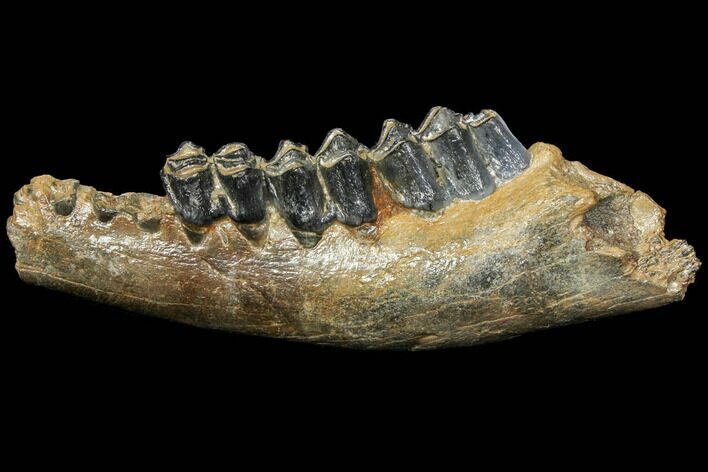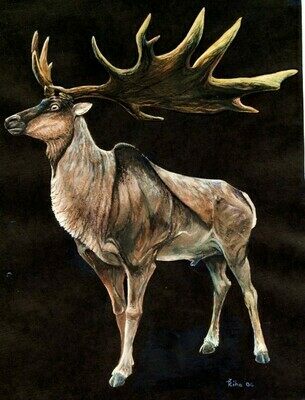This Specimen has been sold.
7.6" Irish Elk (Megaloceros) Jaw Section - North Sea
This is a beautifully preserved, 7.6" long jaw of a 40,000 year old, extinct Irish Elk (Megaloceros giganteus) from the North Sea. This is the right mandible and includes three molars.
Megaloceros giganteus was a giant prehistoric deer with antlers that could grow up to 12 feet across. It's estimated that they could have a body mass of nearly 1,500 pounds, roughly equivalent to an Alaskan Moose.
The Rhine River gravel deposits date from between 250-10k years old. This jaw was found sometime ago when these deposits produced higher quality fossils. Today the gravel quarries and river dredges in Europe are more mechanized and more destructive to fossils and mining methods in the past.
Comes with a stand.
Megaloceros giganteus was a giant prehistoric deer with antlers that could grow up to 12 feet across. It's estimated that they could have a body mass of nearly 1,500 pounds, roughly equivalent to an Alaskan Moose.
The Rhine River gravel deposits date from between 250-10k years old. This jaw was found sometime ago when these deposits produced higher quality fossils. Today the gravel quarries and river dredges in Europe are more mechanized and more destructive to fossils and mining methods in the past.
Comes with a stand.
These Pleistocene fossils were dredged up by fishing trawlers in the the North Sea between Britain and Denmark. Fishermen routinely find mammoth teeth and many Ice Age fossils in their nets: given the chance that a fossil is accidentally gathered in a net is slim, the sea floor is probably littered with the remains of millions of animals. The cold temperatures and low-oxygen environment of the North Sea have aided in the preservation of these teeth and bones.
While these fossils have been pulled up in nets for more than a century, they used to be frequently discarded. It wasn't until the past two decades that this material has begun to be systematically collected and studied. By recording the locations of their finds and allowing scientists to make observations before the more common material is made available, much has been learned about the fauna that once roamed the land that now lies 30 to 150 feet below the North Sea waters.
You can read more information about this at the following link.
http://www.independent.co.uk/news/science/the-watery-grave-of-europes-monsters-1744973.html
While these fossils have been pulled up in nets for more than a century, they used to be frequently discarded. It wasn't until the past two decades that this material has begun to be systematically collected and studied. By recording the locations of their finds and allowing scientists to make observations before the more common material is made available, much has been learned about the fauna that once roamed the land that now lies 30 to 150 feet below the North Sea waters.
You can read more information about this at the following link.
http://www.independent.co.uk/news/science/the-watery-grave-of-europes-monsters-1744973.html
SPECIES
Megaloceros giganteus
LOCATION
North Sea
SIZE
7.6" long
CATEGORY
ITEM
#111885
We guarantee the authenticity of all of our specimens.
 Reviews
Reviews



















